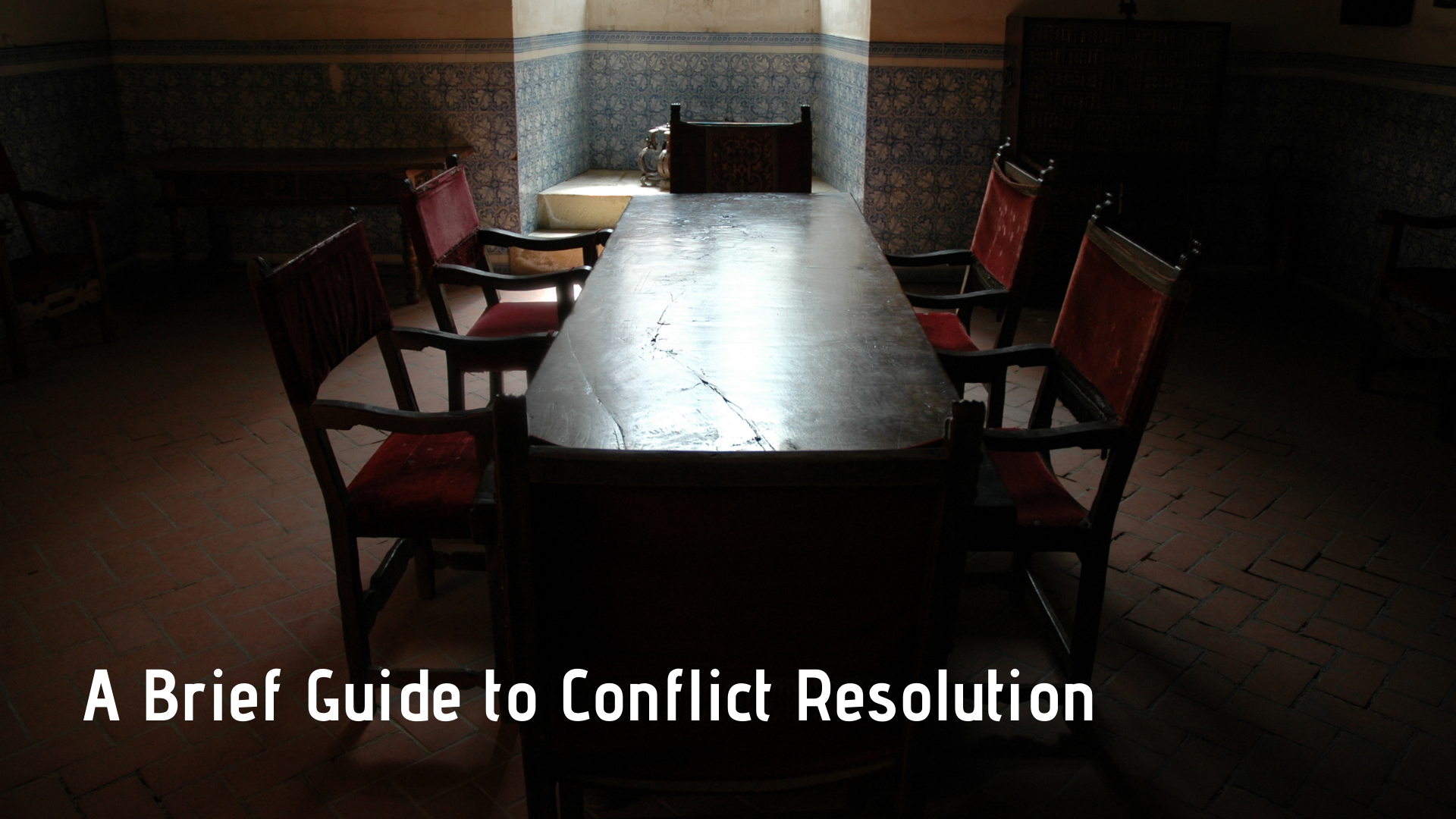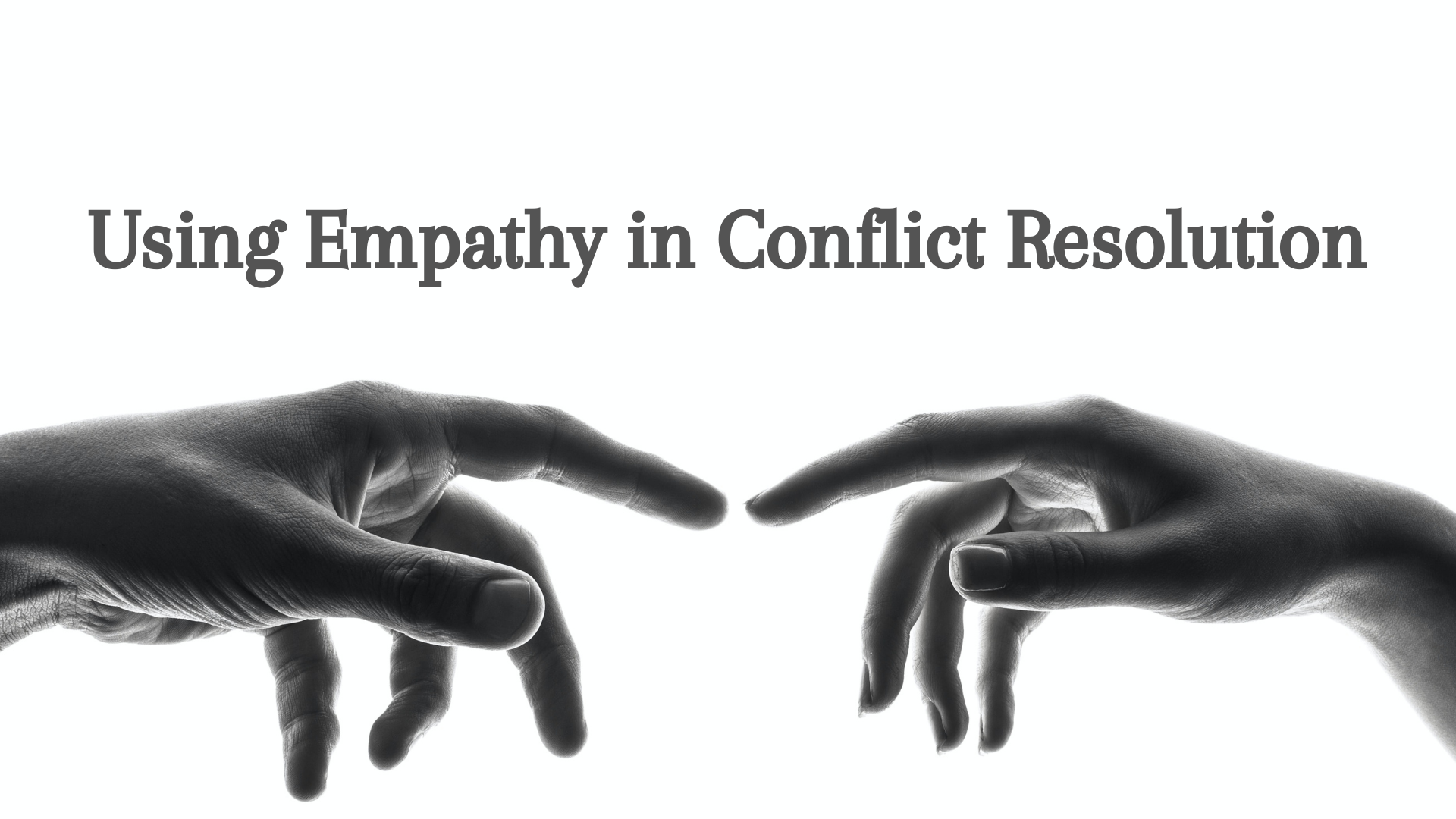A Brief Guide to Conflict Resolution
/Great for election results, Thanksgiving dinners, and generally being a human.
Looking from the periphery, especially at social media, the 2020 Presidential Election has shown us, at least, that our culture ain’t so hot at handling conflict. Some display a childlike, filter-less barbarity in espousing their unnurtured, uninformed, confused vomit of opinions under a veil of objective truth. Others are simply so over the trite goulash of chaos that they are actually asking for cat pictures.
Well, I think it is time to talk about conflict resolution.
At the least, I hope I can offer some semblance of information that can potentially make the process better understood. And not just for post-election politics. From marriages to siblings, co-workers to intercultural failures, we have a lot of conflicts that can be handled better.
Part One — Understanding Conflict
Conflict is a disagreement that results from the perception of incompatible goals or uncertain relational trajectory.
Conflict comes from the Latin phrase ‘con-fligere’ which literally means “to strike with” or “to strike together”. When multiple elements of the world come in contact, friction and tension results.
The first implication is that conflict is natural and inevitable. If you have any kind of contact with another being, there will be conflict.
The second implication is that conflict is not necessarily negative. Your experience of the world is going to be hard. There is going to be conflict. You have very little control of that likelihood. You do, however, have control of what you will do with the difficulty and how you will respond to the conflict.
Conflict itself has no moral value. How you respond to conflict does.
If you want to explore more about the invitation conflict offers and how we ought to respond, you can do so here: The Invitation of Conflict —To never be the same — conflict could be the very answer we are looking for.medium
Once we recognize the ubiquitous certainty of conflict and that it is natural, inevitable, potentially constructive, and contextual, we can begin the adventure of understanding its nature.
Why does conflict happen?
What is the cause of such striking together?
Relational Dialectic Theory
While there are many approaches to this question, a helpful perspective comes from Leslie Baxter; particularly because her explanation involves the role of communication in disclosing the unavoidable experience of conflict.
Essentially, Baxter discusses how the use of verbal communication is our means to handle the constant contradictions that occur in a given relationship. A relationship comprises two (or more) variables in your identity.
You have yourself as a singular person with your own consciousness and experience, but you also have yourself as an interconnected being with this other being. In response, contradictions emerge in reality when these two identities clash.
As communicative beings, our use of language, then, is how we manage the tension and maintain the relationship. Most of the time this is quite mundane. There is a seemingly innate process of managing various contradictions so that the relationship can endure. Baxter calls this relational progress ‘Praxis’ — we continually generate experience with the other person and develop a process to communicate effectively through the contradictions. While the identities still continue to clash with our opposing wants and needs, we make practical decisions to healthily progress the relationship and accomplish as many of the various needs between the people involved as possible. Finding this balance is what Baxter calls ‘Totality’ — the contradicting opposites unite and their contradictions are sustainably in balance.
You, then, already know how to properly engage in conflict resolution.
If you have had one healthy relational moment in your life, you’ve proven that you can do this.
However, these compromises are capable of building a head of steam. When the pressure gets to a point where our developed processes are not capable of resolving the contradictions, we experience a heightened conflict where the relationship’s continuation is in question.
Essentially, as we continue to make compromises, dissatisfaction grows and, if not proactively and constructively confronted, we will be at relational odds with one another.
Baxter has a list of the various contradictions that we experience. While not necessary for the meta-level view on conflict resolution, they are certainly intriguing to consider:
Openness and Closedness: Relational partners expect openness while the individuals that make up the relationship desire privacy.
Certainty and Uncertainty: Certainty bonds the relationship and creates predictable comfort. However, predictability and stability will never be constant and, as people naturally change, the need for difference and surprise clashes with our desire for certainty.
Connectedness and Separateness: The physical, mental, and emotional bond of a relationship are necessary to promote commitment. However, too much connectedness can make one feel as if they are no longer exist individually.
How we engage with these — whether through altering our behavior and alternating between the dialectical contradictions, denying or segmenting one side of the contradiction, developing methods to integrate, balance, or accept the contradictions, or simply terminating the relationship so you don’t have to deal with contradictions — will determine the health and satisfaction of the relationship.
Frequently, you meet partners, couples, family members, or friends who once experienced incredible openness and have begun desiring more privacy; or who feel like their relationship is monotonous. Though a stereotypical trope, how many spouses have lost many of their friends because of poor handling of the ‘Connectedness and Separateness’ dialectic in their marriage?
This exploration, however, is not the intention of the writing.
We only need to understand conflict as an inevitable, natural, potentially constructive, and contextual certainty in our relationships and that communication is essential to navigating a conflict-ridden world.
Part Two — Approaches to Conflict Resolution
At this point, you can use your natural life experience to handle the conflict.
At best, you’ve garnered good experience and the conflict will find mediation.
More likely, you are guessing at what to do in engaging the conflict. A successful mediation would be a stroke of luck.
At worst, you will fumble your way through an argument; objects may be thrown, couches may be slept on, and the future of said relationship will be in question.
If your self-confidence in being a seasoned conflict reconciler is high, read no further. If, however, you wouldn’t mind being a little more informed as to what is happening in a conflict resolution situation and how it should and should not work, there is much insight to be gleaned and, therefore, healthier conflict resolutions to be had.
Types of Conflict
In approaching conflict, there are four general categories that one may be predisposed to:
Active Constructive — exemplified by the use of voice.
Active Destructive — the disposition to exit the conflict.
Passive Constructive — the prioritization of loyalty by at least one member of the conflict.
Passive Destructive — the disposition to neglect the conflict while allowing it to linger.
As you can probably assume, Active Constructive is generally agreed as the most effective means of engaging with conflict. But how does this happen?
First, let’s look at various styles of conflict.
Strategies of Conflict Management
The following strategies, or styles, of conflict situations are commonly discussed in terms of what is called a ‘Dual Concern’. The assumption is that a person in conflict will generally fall somewhere on a spectrum of two primary concerns:
Concern of self
Concern for other(s)
Self-concern typically leads to assertiveness and other-concern is usually described as the use of empathy.
If we look at the five most common strategies, we can see how these concerns develop the disposition of those in conflict and the environment of the mediation situation.
Strategy #1 — Avoidance
You may be a conflict avoider. If not, I’m willing to bet that you’ve met someone who proclaims a tenacious avoidance of conflict.
Avoidance is a strategy that has low concern for the self (and is not active in asserting their desires) and low concern for the other (and does seek to fulfill the other’s desires). Psychologically, a conflict-avoider uses reactive approaches to issues and seeks to neglect them or pretend they don’t exist in the first place. Physically, mentally, and emotionally, they remove themselves from the experience in hopes that by withdrawing, the conflict will magically disappear.
With much dust under the rug, the conflict, however, remains and the outcome is lose-lose.
Strategy #2 — Yielding
Also known as accommodating, yielding happens when we suppress our experience and submit to the other. Especially if the other is dominant (see Strategy #3), we seek to be a peacemaker.
This approach, then, has low concern for the self (and is the opposite of being self-assertive) and high concern for the other (using empathy to satisfy their desires at the expense of your own). They win and you lose.
When both people yield, you end up with a quaint, slightly passive-aggressive conversation of which comedians make fun of Mid-Westerners for.
Strategy #3 — Competitive
A competitive approach is most evident by the use of force; mostly rhetorically, but can certainly occur with the use of physical force. At least one individual asserts themselves to dominate the other making for a high concern of self and a low concern of the other.
These conflict situations are described by the use of argument, insults, and power tactics used to intimidate the other person and get them to accept your views in the hopes of satisfying your desires at the expense of theirs. You win, they lose.
Don’t look too hard for an example. Pretty much all of 2020 is a case study in this approach. American politics, in general, is founded on such a principle.
Strategy #4 — Conciliation
This strategy is best described as the process of compromise — a sort of bargaining that has a moderate concern for self (and will assert some desires) and a moderate concern for the other. Conciliation desires fairness by using a mutual give and take so that both parties (kind of) win.
There is a hint that, while this strategy seems better than the others listed so far, we aren’t quite there. At the same time, this is the assumption most people have concerning what conflict resolution consists of.
Strategy #5 — Cooperation
Here, competition is off the table. Instead, those in conflict, as opposed to holding onto specific positions, articulate their interests and use creative problem-solving to integrate the desires of both parties.
Cooperation has a high concern for self (and asserts the self’s desires) but also a high concern for others (and actively engages in empathy to promote the interests of the other). The goal, then, is a full-scale win-win.
You may notice that there is some yielding occurring so that the self doesn’t assert itself at the expense of the other. However, there is a mutual interdependence amongst the participants so as to satisfy everyone involved to the greatest extent. When the approach is taken that each participant is invested in themselves and one another, the interest of all can be integrated with the hopes of finding collective agreement.
In Western society, this disposition is rare. An exploration of individualism versus collectivism reveals roadblocks to accomplishing this strategy as neither cultural disposition is certain to produce healthy cooperation (Individualist cultures tend towards competition, Collectivist cultures tend towards avoidance or yielding), yet both are capable of fostering a cooperative, collaborative approach to conflict resolution.
Models of Conflict Resolution
A brief glimpse at a small survey of common conflict resolution theories shows the emphasis on attaining the strategy of cooperation while also unpacking some of the practical requirements of doing so.
Various models presented in theories are interacting with what is sometimes called the ‘Conflict Resolution Curve’ which acts as a sort of spectrum to the amount of aggression and accommodation suggested for successful, healthy mediation.
Let’s look at how the following theories may relate to particular strategies.
Cooperative Model — (Deutsch)
This model suggests that one must bring a cooperative orientation to negotiation. Through trust and mutually beneficial intentions, both parties can win.
What this theory emphasizes is that one must have a balance to their goals. They must still hold onto their self-assertion, thereby confronting avoidant or yielding strategies, but must also consider the goals of the other, thereby confronting a competitive approach.
Taken at face value, the Cooperative Model can easily stop at conciliation and is more concerned about getting participants to consider win-win scenarios and pay attention to the concerns of both the self and the other.
Principled Negotiation Model — (Fisher, Ury)
One of the most mainstream articulations on conflict resolution, the Principled Negotiation Model is one of the best approaches to accomplishing the cooperation strategy.
The most effective function of this model is the suggestion to view a conflict through the lens of interests as opposed to positions. The example they use is of a conflict over an orange. If two parties simply fight over the orange, one will have to win and another will have to lose or they could compromise and split the orange. However, they may find that their interests in the orange are different — one may want the juice and the other may want the rind. Approaching a conflict from the perspective of inherent interests allows both parties to fully win while still respecting their concern for themselves and their concern for the other. The language of mutual satisfaction, integration, and invested problem-solving find fulfillment.
Particularly, Fisher and Ury suggest four standards to enact this model and, therefore, fulfill a truly cooperative approach:
Separate the people from the problem.
Focus on interests, not positions.
Generate options (creative problem-solving).
Find agreement based on objective criteria.
Psychologically, there is a particular disposition towards the relationships within the conflict situation that allows for not just conflict resolutions, but constructive relational futures, as well.
Human Needs Model — (Burton)
Principled Negotiation is a monumental step in conflict resolution progress, however, like most progress, finding one form of achievement leads to new problems in other contexts.
The issue raised in the Human Needs Model is that interests and agreement are good if the conflict does not deal with basic human needs.
Here, the denial of fundamental needs means that both sides are not intrinsically functioning interdependently and, therefore, cooperation will mean one party continuing to forego certain health. Namely, both parties cannot win in a situation of inequality because one party has already determined control and power over the other. If said person does not make compromises, then the unstable relational structure will continue. As a result, that person should not be satisfied with fulfilling their interests if their interests are dehumanizing. Also in contradiction to the Principled Negotiation Model is that, in a case such as this, you can’t separate the person from the problem if their forceful disposition is the cause of the problem.
Issues like boundaries and third-party mediators become essential here, but the Human Needs Model still proposes a methodology for interacting with a conflict resolution situation.
First, the mediation must begin by identifying the needs that are threatened. If the person doing the threatening is truly cooperative, this can happen amongst the parties themselves. Often, a formal mediator is required.
Second, before the conflict can move into a Principled Negotiation approach, the relational dynamic must be restructured so that both people can be accommodated. In short, in situations of human need discrepancies, counseling must precede conflict resolution.
Also of interest, though we may assume this is concerned with interpersonal relationships, this model has been highly useful in national conflicts where tyrannical or imperial relationships exist.
Conflict Transformation Model — (Bush, Folger, Lederach)
Many theories exist utilizing this concept which seeks to eliminate unequal distributions of concern for either the self or the other by various parties. Conflict Transformation, then, is about addressing potential negative attitudes and communication patterns that are inhibiting the cooperation strategy.
This model assumes that cooperation is the goal, but practically understands the need to transform the participant’s dispositions before such a strategy is realistic.
Namely, there is a focus on discourse to understand one’s own concerns, recognize the other’s concerns, and give attention to how previous postures, behaviors, and communication patterns have inhibited mutuality.
Conflict Transmutation Model
Various theorists have expanded on the Conflict Transformation Model with a slight adjustment. Both of these models are primarily in response to Principled Negotiation and the goal of the cooperative strategy, but the focus of the Conflict Transmutation Model, which takes its cue from alchemy, is about altering the state of the participants so that they can engage the conflict in another form inherently different from the approach which brought them to the conflict.
The focus of this model is not just addressing negative attitudes and communication patterns, but addressing the underlying factors and sources which brought them to a place of avoidance, yielding, or competition and those factors which caused the conflict in the first place.
Only then, the model argues, can both parties mutually problem solve and search for agreement.
The Goal of Conflict Resolution
Looking at the various models and strategies, the desired outcome ought to be cooperation, even if you need to take some other steps to get there.
At the end of a meditation situation, if both parties leave with both of their interests fulfilled at the same time and with a deeper sense of connection, mutuality, and investment as interdependent collaborators then the hopes of having high concern for both the self (assertiveness) and the other (empathy) will lead to a satisfying win-win.
In terms of the types of conflict, this would be the Active Constructive type which is exemplified in the cooperative strategy.
While the other strategies have their place — even conciliation can be positive — cooperation is resoundingly promoted. Principled Negotiation may be the most tactile model for achieving such ends, but, because of our tendency towards other strategies, the other models are certainly worth considering in accomplishing the active, constructive vision of cooperation.
But here’s where the goal is most important.
Because when you interact with the natural, inevitable reality of conflict in this way, you are not just resolving a conflict.
You are exemplifying the greatest propensity of being human.
Part Three — Additional Tips for Successful Conflict Resolution
Embedded in the theories, models, and strategies are some clear behavioral and mental actions that are worth emphasizing.
If remembering all the nomenclature is not high on your agenda, there are some practical steps to accompany the theoretical guise.
First, focus on reaching agreement. While this can still occur in making compromises, full agreement should be pursued by fully satisfying both parties. When those parties also stop seeing themselves as separate parties, but as a singular, interdependent unit, the likelihood of agreement is exponentially increased. Beyond an agreeable outcome, however, those involved should be spending time finding agreement on what the problem is, where the problem came from, what behaviors and communication have been problematic for the conflict, and how each one perceives the nature of all of these components.
Second, reduce tension and de-escalate hostility. Doing so may require an unbiased mediator. Sometimes, this will involve separating those in conflict and allowing each to process the situation independently. However, eventually, a catharsis must occur in which each person has the opportunity to explain their experience and acknowledge the other’s experience. Both understanding and expressing all perspectives are instrumental in fostering an active, constructive approach to conflict resolution.
Third, pay attention to communication. How information is relayed can greatly promote or detract from the purpose and goal of mediation. This will be addressed further below.
Fourth, focus on issues singularly. The complex web of relationships often leads to intersecting various problems and making connections that cannot be solved as a conglomerate. When approached singularly, however, solutions begin to intersect and the various problems of a large conflict begin to clearly emerge.
Destructive Behaviors to Avoid
To further explore the above tips and, in the admission that we tend to naturally engage with conflict poorly, it is worth emphasizing what not to do before we consider the primary practices we ought to do.
Let’s first come back to communication.
The non-verbal and verbal communication used can greatly inhibit our goal in conflict resolution. Here are forms of communication that are, typically, not helpful:
Silence — (usually a reflection of withdrawal or avoidance).
Reactive communication — (emotive outbursts or verbal attacks to detract from the real issues).
Indirect communication — (often passive, sometimes passive-aggressive, we need to be clear about what we are trying to say).
Arguing — (our initial response to information about us is to defend ourselves. Remember, cast aside your position if you are going to achieve the interests of both).
Strategies to Avoid:
Ascribing motives — (don’t assume you know why they did what they did or how they are feeling. Listen and give them the chance to directly express themselves).
Ad Hominem arguments — (if the person expresses something, separate the person from the problem; separate their position, emotion, or action from their inherent identity as a human being).
Counter blaming — (when feeling attacked or in the wrong, don’t attempt to shift focus away from yourself by blaming others).
Demanding withdrawal — (often as a means of escaping, don’t try to forcefully end a conflict situation by intimidating the other into giving up. You may avoid negative ramifications, but you will also ensure constructive possibilities are eliminated).
False logic — (synonymous with the problem of conflating separate issues and combining categorical conflicts into a singular conflict, avoid presenting your interpretation of a behavior or situation as fact. You can certainly express your interpretation, but don’t assume your story is the only, objective story. Humans have a tendency to fill in the blanks with their imagination. Approach the content of a conflict as objectively as possible while honoring the subjectivity you have experienced).
Arguing about different issues — (a potential unintentional act, be aware if your responses to issues are about the same issue. Bringing in separate information to explain your response to what the other party said will keep from addressing the issue at hand).
Spiraling negativity — (a conflict meditation can easily get out of hand. Using tactics such as ascribing motives, counter blaming, or arguing about different issues can easily create an environment of slewing the negative and, therefore, digging in on your positions).
Stubbornness — (again, holding onto a position and competing for your concerns at the expense of theirs is undeniably a quick way to stalemate a conflict and ensuring satisfaction and constructive outcomes will be at a minimum).
Skills & Strategies to Utilize
Quite simply, the opposite of the above should occupy our dispositions, but I’d like to elaborate on a few specific approaches to conductively realize cooperative conflict management.
Reflective Listening:
A signpost of empathy (and, therefore, upholding concern for the other), reflective listening is not just listening; it is affirmative listening that pays attention to details, emotions, and non-verbals while using unobtrusive feedback to affirm the person’s communication and invite further expression and response.
There are six different forms of feedback that are all designed to convey understanding and promote continued discourse.
Not all communication, verbal or non-verbal, is reflective. Eye contact is important and a slight nod can be helpful, but you can also interrupt with non-verbals or act bored.
Essentially, reflective listening is a way to reflect back to the person an undistorted and accurate image of their own process. Mastering this art is complex, but the intention is half the battle.
Accepting Criticism:
To deter your inherent defensiveness, a posture must be owned of willingly hearing critiques. Accepting a rebuke does not mean that their criticism is objectively correct. It simply means that you accept their experience. The attack they offered is likely not absolutely true. It is true, however, that they have physically, mentally, or emotionally experienced that issue. In so being, that is now information that the mediation must work with — whether or not it is factual.
Be Honest About Your Own Subjectivity:
Just as their experience is not the whole story, neither is yours. Your perspective is valid and must be honored, but it must be recognized as limited. Neither party is working with all the information. If the answers and the truth were so easy, we would not need mediation and, most likely, we wouldn’t have conflict.
Complexity, however, abounds.
If both parties can admit their limited, finite place in the world, opportunity for leaving with a more informed perspective exists.
More must be said about this reality and you can find an in-depth take here: Let’s Talk About Your Perspective — What is a ‘perspective’? And how can you change it?
Mapmaking Vs. Arguing:
We’ve already addressed the detriment of argumentation as a means to resolve conflict. In its place, and in collaboration with the cooperative strategy and the Principled Negotiation Model is a technique called mapmaking.
The simple version is that, instead of approaching an issue in terms of competition, where you must hold to your position and defend it, mapmaking encourages both parties to take the information they are working with and add it to the pool of knowledge for both to share. At the end of the venture, both people will have a more full version of the map than when they started; especially if they realize the insanity of arguing about whose version of the map is better.
Again, a fuller treatment can be found here: Mapmaking Vs. Arguing — In the age of debate, here’s a suggested method for disagreeing well
Part Four — Two Final Words
All of this is an ideal approach to conflict resolution. Needless to say, there are (at least) two people involved in a conflict. Problem is, you can only control one of those people.
So what do you do if cooperation is not possible, especially if such lack of participation can be harmful to you?
Our first final word — create boundaries.
There may come a time when potential resolution is no longer possible. Please attempt the healthy processes above as much as possible, but be willing to admit when peace is hopelessly futile.
Conflict resolution is certainly desirable, but it is available in certain contextual realities in which a person has chosen termination over healing. The only suggestion I can give if you find yourself in this situation can be found here: The Taboo of Changing Other People — How we can change people well — via tigers, prophecy, & Pygmalion
But let us end by speaking a second word to connect the dots of navigating a world in which conflict will be constant.
Common bond.
The key to unlocking conflict resolution is the collaborative, cooperative approach where invested trust and commitment set the stage for mediation.
Your commitment to the person on the other side of the table must transcend the conflict itself.
Here’s the deal — we are strange beings. When we come in contact with each other, our contradictions make the potential beauty uncertain. Our diversity may drive us apart.
Recognizing the common bond that holds us together gives us a unity in which our diversity can be held — even utilized — to foster the relational potential of human such as us.
In whatever conflict you find yourself, commit to the process of cooperation.
Because if we don’t, one of us will lose.
And if one of us loses, we all lose.
For Futher Reading:
Many concepts and practices were alluded to in this piece that, if you are interested, may be worth your time to explore further.
Here is a selection primarily focused on relationships and communication outside of the ones already linked in the article:
Relational Attachment Patterns For Healthier Relations
How Do We Engage With Others?medium.com
People Pleasing & The Way Out
What is “people pleasing” and what can we do about it?medium.com
Community: The Four Defining Ingredients
How community was lost and how we can recover it.medium.com













![Three Reasons We're Lonely - [And Three Responses For Being Less So]](https://images.squarespace-cdn.com/content/v1/5963d280893fc02db1b9a659/1651234022075-7WEKZ2LGDVCR7IM74KE2/Loneliness+3+update+%283%29.png)





























